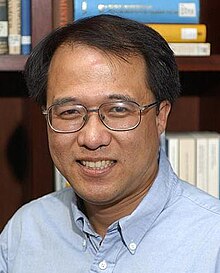Xiao Gang Wen
Xiao-Gang Wen (born November 26, 1961 in Beijing ) is an American physicist who deals with theoretical solid-state physics. He was a professor at the Massachusetts Institute of Technology (MIT) and has been with the Perimeter Institute since 2011 .
Life
Wen studied at the University of Science and Technology in Beijing with a bachelor's degree in 1982 and at Princeton University with a master's degree in 1983 and a doctorate in 1987. There he worked with Edward Witten on superstring theory . As a post-doctoral student he was a member of the Institute of Theoretical Physics at the University of California, Santa Barbara , where he worked with John Robert Schrieffer , Frank Wilczek and Anthony Zee and turned to solid state physics. From 1991 he was assistant professor, 1995 associate professor and since 2000 professor at MIT. Since 2011 he has held the Isaac Newton Research Chair at the Perimeter Institute for Theoretical Physics .
plant
Wen did research on topological order in systems such as the quantum Hall effect . He introduced the concept of topological order in 1989 to describe quantum Hall liquids that cannot be described by the classical theory of phase transitions (with broken symmetries and order parameters) in the sense of Lew Landau . In 2001 he introduced the concept of quantum order in general.
He uses solid-state systems as models (spin models on grids) for unified theories in elementary particle physics ( String Net Physics ). The inspiration was the observation of fractional charges (including a charge one third similar to that of quarks) in the Fractional Quantum Hall Effect (FQHE). Wen sees this as an example of new topological phases of solid-state systems with string-like description by quasiparticles . With Levin he found that the string liquids can be described by the Maxwell equation and that the ends of the strings give models for fermions (electrons) (later they could also use them to model gauge bosons and quarks and gravitons), so that a solid-state model can be created of elementary particle physics. Wen hopes to have found an experimental model for these theories in the Herbertsmithite synthetically produced by his colleague Young Lee at MIT (to avoid impurities in the crystal structure) . In the mineral, the electrons are arranged trigonal in a two-dimensional lattice in triangles . The preferred spin direction of neighboring electrons is antiparallel, but the third electron must align itself parallel to one of the other two. The system becomes frustrated , resulting in random fluctuations in spin and spin fluidity.
He also has applications to topological quantum computers (a concept introduced by mathematicians Michael Freedman and Alexei Kitajew in the 1980s).
With Patrick A. Lee he developed a SU (2) theory of high temperature superconductors .
Honors and memberships
From 1993 to 1995 he was a Sloan Research Fellow . In 2006 he was a Moore Scholar at Caltech , from 2002 to 2004 he was visiting professor at the Center for Advanced Study at Tsinghua University and in 2009 visiting professor at the Perimeter Institute. He is a Fellow of the American Physical Society (2002). For 2017 he was awarded the Oliver E. Buckley Condensed Matter Prize , in 2018 he was elected to the National Academy of Sciences and also in 2018 he received the Dirac Medal (ICTP) .
Fonts
- Quantum Field Theory of Many Body Systems , Oxford University Press 2004
- with Michael Levin Photons and Electrons as emergent phenomena , Reviews of Modern Physics, Volume 77, 2005, pp. 871-879, Arxiv
- with Levin String net phases. A physical mechanism for topological phases , Phys. Rev. B, Volume 71, 2005, 045110, Arxiv
- with Zheng-Cheng Gu Emergency of helicity +/- 2 modes (gravitons) from qubit models , Nuclear Physics B, Volume 863, 2009, pp. 90–129 Arxiv
- with Levin Fermions, strings, and gauge fields in lattice spin models , Phys. Rev. B, Volume 67, 2003, p. 245316, Arxiv
- From new states of matter to a unification of light and electrons , Progr. Theor. Phys., Suppl., Vol. 160, 2006, pp. 351-360, Arxiv
- An Introduction to Quantum Order, String-net Condensation, and Emergence of Light and Fermions , Annals of Physics, Volume 316, 2005, p. 1, Arxiv
Web links
Individual evidence
- ↑ Wen, Witten Electric and magnetic charges in superstring models , Nuclear physics B, Volume 261, 1985, pp. 44, 651
- ↑ Wen Quantum order: a quantum entanglement of many particles , Physics Letters A, 300, 175 (2002)
- ↑ Wen Theory of Everything (for some universes)
- ↑ Merali The universe is a string-net liquid , 2007 (originally New Scientist)
- ↑ Patrick A. Lee, Naoto Nagaosa, Xiao-Gang Wen Doping a Mott Insulator: Physics of High Temperature Superconductivity , Rev. Mod. Phys. 78 17-85 (2006)
- ↑ PA Lee, N. Nagaosa, TK Ng, XG Wen: An SU (2) Formulation of the tJ model Application to Underdoped cuprate . In: Physical Review B. Volume 57, 1998, p. 6003
| personal data | |
|---|---|
| SURNAME | Wen, Xiao gang |
| BRIEF DESCRIPTION | American physicist |
| DATE OF BIRTH | November 26, 1961 |
| PLACE OF BIRTH | Beijing |
